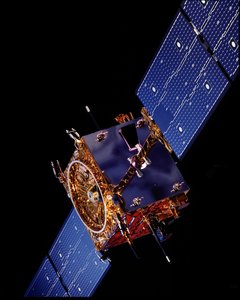Smart 1
|
|
Smart 1 or SMART-1 is a lunar ESA satellite that relies on a solar powered ion thruster to put it into orbit around Earth's Moon. "SMART" stands for Small Missions for Advanced Research in Technology. (LISA Pathfinder is the revised name for SMART-2, and is planned to be launched in 2008.) SMART-1 is the first European spacecraft to go to the Moon.
| Contents |
Spacecraft design
SMART-1 is a lightweight probe (at launch 815 pounds or 367 kg, reducing to 287 kg by using fuel), just one metre (approximately 3 feet) across. The total cost is a relatively low: EUR 110 million (USD 126 million). SMART-1 is part of the European Space Agency's strategy to build spaceships smaller and more cheaply than those of its American counterpart, NASA.
Its solar-powered ion thruster (Solar Electric Primary Propulsion, SEPP) is a Hall effect thruster (PPS-1350). It is designed to give it more endurance than a space probe equipped with traditional chemical rockets. The onboard fuel reserve amounts to just 60 litres (about 16 U.S. gallons) of inert xenon, with a mass of 80 kg. The thrusters use an electromagnetic field to project xenon ions at high velocity.
The specific impulse is 16.1 kN·s/kg (1640 lbf·s/lb), more than three times the maximum for chemical rockets. Therefore 1 kg of fuel (1/350 to 1/300 of the total mass of the spacecraft) produces a delta V of ca. 45 m/s, more than three times what a chemical rocket would produce.
1190 W is available for powering the thruster, giving a nominal thrust of 68 mN, hence an acceleration of 0.2 mm/s² or 0.7 m/s per hour. Thus orbital maneuvers are not carried out in short bursts, like with chemical rockets, but very gradually, with on-time typically once every orbit for about one third to one half of the time (when spiralling out: at the perigee side). In the lifetime of 5000 hours a delta-v is provided of 4 km/s, corresponding to a total impulse of 1.5 MN·s.
Mission
As a part of "Small Missions for Advanced Research in Technology", SMART-1 will test new spacecraft technologies. The primary objective of SMART-1 is to test the solar-powered ion thruster. It will also be testing the miniaturized scientific instruments, which are thought to be more efficient. If successful, these technologies will be used on future ESA missions.
A secondary objective is to learn more information about the moon, such as how it was created. SMART-1 will map the lunar surface by way of X-ray and infrared imaging, taking images from several different angles so that the moon's surface can be mapped in three dimensions. It will also determine the moon's chemical composition using X-ray spectroscopy. A specific goal is to use infrared light to search for frozen water at the moon's south pole, where some areas of the surface are never exposed to direct sunlight. It is also mapping the moon's Peak of Eternal Light, an eerie mountaintop which is permanently bathed in sunlight and surrounded by craters shaded in eternal darkness.
Flight
SMART-1 was launched September 27, 2003 together with INSAT-3E and e-BIRD, by an Ariane 5 rocket from Kourou, French Guiana. After 42 minutes it was released into a geostationary transfer orbit of 654 x 35 885 km. From there it used its SEPP to gradually spiral out during thirteen months. On November 11, 2004 it passed near the L1 Lagrangian Point and passed into the area dominated by the moon's gravitational influence, and at 1748 UT on November 15 passed the first perilune of its lunar orbit.
On October 26, 2004 after the 289th engine pulse, the SEPP had accumulated a total on-time of nearly 3648 hours out of a total flight time of 8000 hours, hence a little less than half of its total mission. It consumed about 58.8 kg of xenon and produced a delta-v of 2737 m/s (46.5 m/s per kg xenon, 0.75 m/s per hour on-time). It was powered on again November 15 for a planned burn of 4.5 days to enter fully into lunar orbit. It will take until February 2005 using the electric engine to decelerate into the final orbit 300-3000 km above the moon's surface.
ESA announced on February 15, 2005, the endorsement of a proposal to extend the mission of Smart 1 by one year until August 2006.
Important events and discoveries
| Missing image Europe_and_Africa_smart1_20040615.jpg Earth seen from SMART-1 | Missing image Fig2-410.jpg Area near Lunar north pole, January 19, 2005 |
- June 17, 2004: SMART-1 took a test image of Earth with the camera that will be used for Moon closeup pictures. It shows parts of Europe and Africa. It was taken on May 21 with the AMIE camera, a compact imaging device with a weight of 450 grams.
- November 2, 2004: Last perigee of earth orbit.
- November 15, 2004: First perilune of lunar orbit.
- January 15, 2005: Calcium detected in Mare Crisium.
- January 26, 2005: First close up pictures of the lunar surface sent back.
- February 27, 2005: Reached final orbit around the Moon with an orbital period of about 5 hours.
- Early 2005: The search for Lunar Peaks of Eternal Light begins.
External link
- ESA SMART-1 homepage (http://sci.esa.int/science-e/www/area/index.cfm?fareaid=10)da:SMART-1
de:SMART-1 fr:Programme Smart 1 it:Sonda Smart 1 he:סמארט-1 nl:SMART-1 ru:SMART-1 fi:SMART-1 sv:SMART-1 zh:SMART-1

